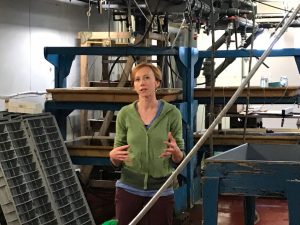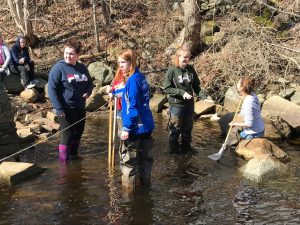Looking with an eye for details…making measurements…Students worked in small, self-selected groups, using a rubric to guide their content as they completed a final draft of a site description. The last stages of the work involved a peer feedback process giving “warm” and “cool” feedback according to a protocol, with which groups could consider revisions.
 .
. 
Revisions were made and the quality of their final illustrations and text descriptions changed significantly. Here is a final site illustration and description created by Anna Kingsbury, Allison Gill and Audrey Leavett.
Site Description
“Our 8th grade class has been going down to the marsh to try to bring the alewives back. We have found that the outlet stream is 111 feet long. There is a granite pillar that is about 4 ½ feet tall, and ⅓ of the way upstream from the culvert. Three and a half feet downstream from the pillar, there’s a tree stump. The line of rocks is located between the pillar and the tree stump. The line of rocks goings from the east to the west bank and measures 20 feet long. The rocks help to break the surface of the stream. The water upstream from the line of rocks, which is more of a pool than a stream, is about 14-15 inches deep. The water downstream of the line of rocks has a faster current.
Upstream from the rock pillar (on the east side) is squishy mud that makes your boots get stuck. The floor downstream from the pillar is mostly rock and is easier to walk on.
There’s a pile of boulders about ½ of the way upstream from the culvert on the west bank. The widest part of the stream is 26 ½ feet. This is from the boulders on the west side straight across to the east side of the stream.
Ten feet downstream there is a little pool that the water from the outlet flows into, made by rocks. The outlet is 5 feet wide. There is a tree on the east bank that hangs next to the outlet.
This is our site description of the St.George outlet stream.”
















